Arthroscopic Rotator Cuff Repair
Post Op Protocol
Dr Maguire has a very strict protocol for post-op physio for Shoulder Arthroscopic Rotator Cuff Repair.
***** Please note which tendons were repaired *****
NOTE whether Supraspinatus, Subscapularis or Infraspinatus repaired.
The Operative Notes should accompany you on discharge in a folder with other documents including your physio referral. PLEASE give this information to the physio to individualise your rehab.
Also NOTE if a BICEPS TENODESIS was performed!!
Day 1 to day 7
– In hospital ICE / cryo-cuff every 2-3 hours
– Do not put up with pain
– If no contraindications use this pain relief regime
– PCA overnight then change to the following in am:
– Paracetamol 1gram four times a day
– Ibuprofen 400mg three times a day
– 10 to 20 mg of TARGIN (Oxycontin) twice a day
– 5-10 mg of Endone as required up to 3 hourly
– Ensure Fluid intake and bowel softening agents
– Prevent constipation from Endone/Targin
– Remain in sling unless doing physio
– Gentle pendulum exercises
(Forwards/Backwards)(Left/Right)
– Hand, wrist, elbow ROM as tolerated
– External rotation to neutral (0 Degrees only)
– Protect Biceps if Tenodesis performed
– Support Elbow
– No active contraction of biceps
– Scapula exercises (shrugs, protaction, retraction, rolls)
– As frequently as tolerated
Weeks 2 to 6
– Continue exercises above
– Wean off Targin and Endone after first week
– Abduction sling on unless showering, eating or sitting
– Sling ALWAYS on for sleeping and when mobilising
– Gentle Pendular movements (Assisted)
– PROM (Passive Range of Motion) only!
– PROM Supine FE gently up to 140 (only 10 reps max)
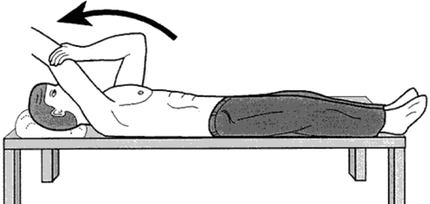
– Table slides into FE as tolerated (only 10 reps max)
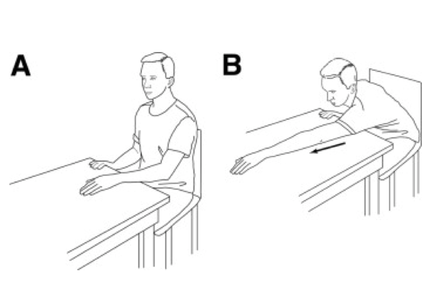
Figure 1. Table slide. (A) Starting position. While seated at a table, the patient places the hand of the affected shoulder on a sliding surface (e.g., a magazine that slides over a smooth table surface). (B) Ending position. The patient slides the hand forward, maintaining contact with the table, while the head and chest advance toward the table.
– External Rotation (ER) to 30 degrees (only 10 reps max)
– If large subscapularis tear ER to neutral till wk 6
– Internal rotation to buttock (only 10 reps max)
– Warm-up before exercises
– Walk for 1 minutes
– Warmth to shoulder (warm pack or warm shower)
– ICE after exercises for 30 mins
– Use core muscle exercises and lower limb exercises from Day 1 post Op
– e.g. Kibler Kinetic Chain Theory
– Protect Biceps if Tenodesis performed
– Support Elbow
– No active contraction of biceps
– Aerobic exercise (walking or stationary exercise bike)
Weeks 7 to 12
– Continue above exercises
– Discontinue sling after 6 wks unless massive tear (8wks)
– Small RCTs <=1cm begin Assisted AROM at 7wks
– Medium RCTs 1 to 3cm begin Assisted AROM at 8 wks
– Large RCTs 3 to 5 cm begin Assisted AROM at 9 wks
– Massive RCTs > 5cm begin Assisted AROM at 10 wks
– Assisted AROM includes “wall walking” for FE
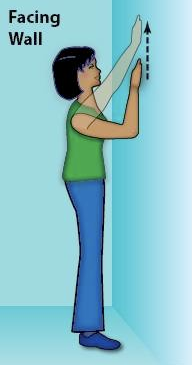
– Push PROM to achieve FROM (Full Range of Motion)
– Isometric contractions of Rotator Cuff at Week 8
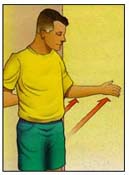
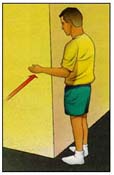

– Start gentle theraband work 2 wks after Assisted AROM
– Only for cuff muscles not repaired
– e.g. Medium Tear at 10 wks
– Start gentle theraband work on musles repaired
– 4 wks after Assisted AROM started
– e.g. Medium Tear at 12 wks
After 12 weeks to 6 months
– Continue above exercises
– Begin Gym program
– May start running and pool work
– Progress from gentle breastroke to freestyle
– Avoid heavy lifting for 6 months
– Lift with arms close to body
– This avoids the “Lever Arm Effect”
– If significant stiffness or pain at 12 wks may consider corticosteroid injection
6 months to 12 months
– If stiffness persists for 12 months may consider arthroscopic capsular release

